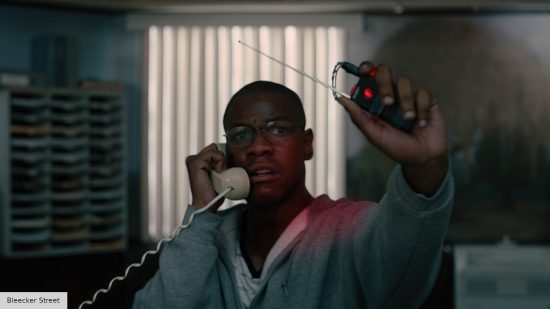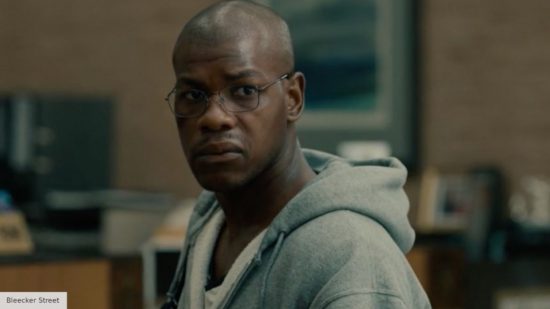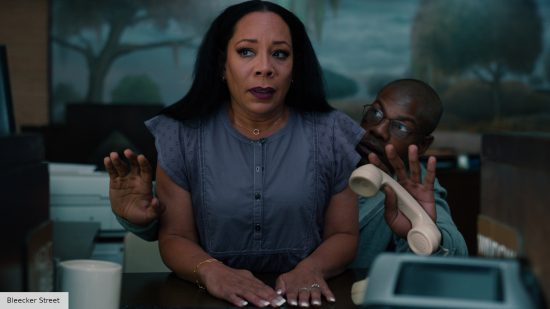In the thriller movie Breaking, we follow one man, Brian Brown-Easley, as he holds up a bank in order to receive benefits he’s been cheated. The movie based on a true story doesn’t have a happy ending, but that’s what makes its documentation so necessary.
Director Abi Damaris Corbin co-wrote the screenplay with Kwame Kwei-Armah, making the drama movie even more personal than it already was. On the back of the film’s screening at the Glasgow Film Festival, Corbin explained to The Digital Fix about the challenges in putting together the tense negotiation that forms the main narrative thrust.
We chat about Michael K Williams and John Boyega collaborating, as well as the various changes that happened during production. Perhaps most importantly of all, Corbin tells us what she hopes audiences will take away from her retelling.
Something that’s remarkable about Breaking, to me, is how almost minimalist it is. Can you tell me about setting the film almost entirely within one location?
Thank you, I appreciate those words. It’s an enormous challenge to make [it] feel simple, because it’s very much not. It’s something that to have layer upon layer.
It requires the immense dedication of a lot of artists to come together and make sure that you’re working in harmony and that you’re honouring the film as it progresses.
Really my cinematographer, my production designer, my producers, John [Boyega], each person really worked in concert to make sure that that was the case.
I read an interview with the editor of film, Chris Witt, and he talked a lot about the psychology around Brian, of keeping that real-time feel as we’re sitting in his mind. What are the challenges of telling a story in what’s close to real-time?
It’s hard. It’s tracking the light when you’re shooting 12-hour days, 14, whatever it is, and making sure that everything feels consistent on set and making sure that you’re also shutting down traffic at the right time.
It’s not intended to have 50 cars in the background, so that take is definitely going to work when the road is supposed to be locked down. It’s tricky in terms of just the logistical challenges of it.
Then on the creative side of it, something that takes place over the course of one day, but it’s supposed to be a snapshot representative of a man’s life, you better do your homework and make sure what’s happening on that day matters.
You mentioned the snapshot of this man’s life. I’m just wondering, what was the first impression you wanted us to get of him?
I wanted to set up a question for the audience that we could then answer.
The events in the bank are a second part of the story – Brian had this incident where he was escorted out of where he was trying to get this money. Can you talk about constructing those flashback scenes and not wanting them to overpower the story because the real story is in the bank?
That’s exactly how we wanted it to feel. We wanted you to know that there was more. But we also wanted to leave negative space so that you went into your reserves, that there were spaces for you to access Brian’s story to understand that the day in the bank was a snapshot of all the things he faced in his past, and you face in your past and your friends and family. The systems that you faced, we wanted you to have space for your memory.

I understand that John Boyega was not the original actor. It was Johnathan Majors first. How did that change the movie?
I really do believe the person who’s supposed to be in the room is in the room. And John has an enormous amount of empathy. And his face is so emotive. It just shines through; he might laugh, he might cry.
He just belonged there. So it’s impossible to really know how things would have shifted, but just in a practical sense, it enabled me a lot of freedom to work with him because he is such a free artist in his craft.
John Boyega and Michael K Williams are intense co-stars, but they never make the film. What was their working relationship like?
They respected each other a lot. And that was very clear. Mike called John the ‘Young Boyega’, and said he was so looking forward to working with him.
John had been a longtime fan of The Wire and the legacy of incredible work that Mike had already created, that it was such an easy collaboration between the two of them because it was built on respect for the craft, for each other, and the way that they had moved in the world.
Then, on set, they were just off camera. Every time the other person was on screen, and they were on the phone. So it really enabled them to do good work, working off of each other.
The film premiered at Sundance last year under a different name. What kind of changes were made between then and the version now available?
We finished pretty close to Sundance. So there were a couple of tightening things that I did, but nothing significant. It was just like some little edits, tightening things.
I think a lot of people can take away something very personal from it, whether it be anger or sadness. What you like people to take away from Breaking?
I hope, like you said, that the righteous rage is felt, that there’s sadness and there’s anger, but I really hope that, like Brian says, they’ll go and do right by people.
Breaking is available now on digital. You can read our Breaking review here, and check out our new movies list to see what else is coming out this year.


